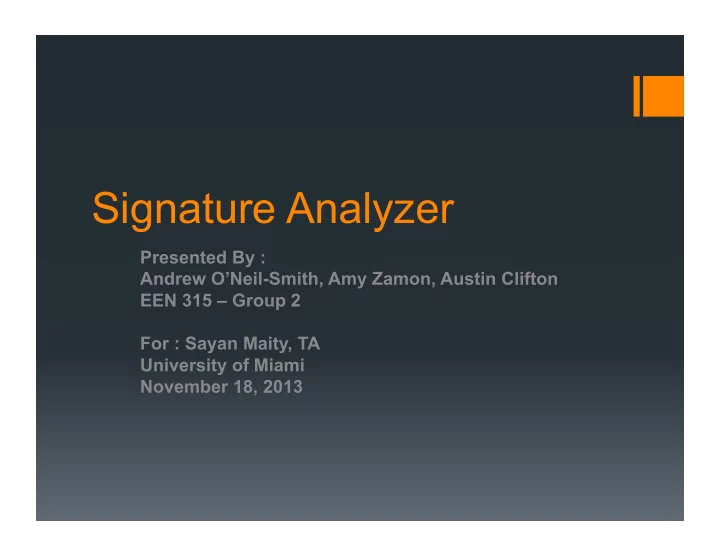

Signature Analyzer Presented By : Andrew O’Neil-Smith, Amy Zamon, Austin Clifton EEN 315 – Group 2 For : Sayan Maity, TA University of Miami November 18, 2013
Project Goals • Understand Shift Registers • Reinforce sequential design • Introduce concepts of testing, signature generation, and pseudo random binary sequence generation • Move away from physical breadboard implementation to digital design
Background Information • A Flip-Flop is the basic memory unit of a sequential circuit • Types – Set/Reset, D, JK, Edge Triggered (clock) vs. Latch (signal level) • Signatures are used to verify correct transfer of data • Basic logic diagrams, truth table construction, Next State Tables • Understanding of multiplexors
Background Information • Basic understanding of truth tables, logic diagrams, transition tables, and next state tables is essential to understanding logic derivations • Truth table for a JK flip-flop: • Equation for a JK flip-flop: Q + = JQ’ + K’Q • Bit shifting: 0110 shifted left = 1100, 1011 shifted right = 0101, etc.
Equipment DESCRIPTION QUANTITY 2:1 Multiplexer 8 D Flip Flop 4 XOR Gate 2
Design Process • Each Flip Flop represents a bit in the register, output of one is input of the next • 2:1 MUX for each Flip Flop determines Parallel or Serial Input • 2:1 MUX for each Flip Flop determines Right or Left Shift • Parallel output is the output of the Flip Flops • Signature Analyzer: XOR the two least significant bits Qd+ = (Qa XOR Qb) XOR PROBE Qc+ = Qd Qb+ = Qc Qa+ = Qb • After 10 clock cycles, will have final signature
Logic Diagram Final logic diagram / circuit / schematic.
Implementation • Design Block Diagram File • Compilation • Input values for Vector Waveform File • Simulation
Sequence 1 Qd Qc Qb Qa PROBE(INPUT) Qd+ Qc+ Qb+ Qa+ 0 0 0 0 1 1 0 0 0 1 0 0 0 0 0 1 0 0 0 1 0 0 1 1 0 1 0 1 0 1 0 0 1 1 0 1 1 1 0 1 1 0 1 1 0 0 1 1 0 0 1 0 1 1 1 0 1 1 1 1 1 0 1 1 1 0 1 0 1 1 1 0 1 1 1 0 1 0 1 1 1 0 1 1 1 0 0 0 1 1
Sequence 1 Simulation
Sequence 2 Qd Qc Qb Qa PROBE(INPUT) Qd+ Qc+ Qb+ Qa+ 0 0 0 0 1 1 0 0 0 1 0 0 0 1 1 1 0 0 1 1 0 0 0 0 1 1 0 0 1 1 0 0 1 0 1 1 1 0 1 1 1 1 1 0 1 1 1 0 1 1 0 1 1 0 0 1 1 0 0 1 0 1 1 1 0 1 1 0 0 1 0 1 0 1 0 1 1 0 0 1 0 0 0 1 0 1 0 0 0 1
Sequence 2 Simulation
Sequence 3 Qd Qc Qb Qa PROBE(INPUT) Qd+ Qc+ Qb+ Qa+ 0 0 0 0 1 1 0 0 0 1 0 0 0 1 1 1 0 0 1 1 0 0 1 1 1 1 0 0 1 1 0 1 0 1 1 1 0 1 1 1 0 0 0 1 1 0 0 1 1 0 0 0 0 1 0 0 0 1 0 1 0 0 0 1 0 0 0 0 0 1 0 0 0 1 0 0 1 1 0 1 0 1 0 1 0 1 0 1 0 1
Sequence 3 Simulation
Sequence 4 Qd Qc Qb Qa PROBE(INPUT) Qd+ Qc+ Qb+ Qa+ 0 0 0 0 1 1 0 0 0 1 0 0 0 1 1 1 0 0 1 1 0 0 1 1 1 1 0 1 1 1 0 1 0 1 1 1 0 1 1 1 1 1 0 1 1 1 0 1 1 1 1 1 0 1 1 1 0 1 1 0 1 1 0 0 1 1 0 1 0 0 1 1 0 0 1 1 0 0 0 0 1 0 0 0 1 0 1 0 0 0
Sequence 4 Simulation
Conclusions • Learned how to use Quartus software to design and implement circuits with simulations. • Mistakes made initially due to lack of familiarity with Quartus software were easily found and fixed as we continued to accustom to wiring a circuit digitally, and we eventually found that wiring digitally is even easier than wiring manually on a bread board. • Successfully implemented a shift register and shift analyzer without any major issues.
Recommend
More recommend